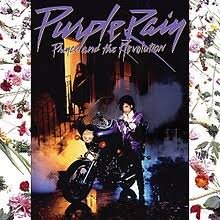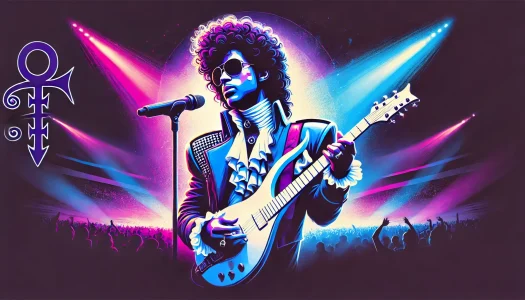When Purple Rain was released in 1984, it wasn’t just an album—it was a cultural phenomenon. Prince’s sixth studio album became a soundtrack for a generation, blending electrifying music with an equally iconic film. It shattered conventional genre boundaries, bringing together rock’s raw power, funk’s irresistible grooves, and pop’s universal appeal into a seamless masterpiece. With hits like “When Doves Cry” and “Let’s Go Crazy,” the album defined an era and catapulted Prince into global superstardom.
The Context: Prince’s Vision and the 1980s Music Scene
By the early 1980s, Prince was already a force to be reckoned with. His previous albums, including 1999, had cemented his reputation as a groundbreaking artist, blending funk, R&B, and new wave influences. With hits like “Little Red Corvette” and “1999,” he proved his ability to craft music that was both innovative and commercially successful. However, Prince wasn’t content to merely ride the wave of his early success—he envisioned something bigger: a project that would elevate his artistry and expand his reach to a global audience.
The 1980s music scene provided a unique backdrop for Prince’s ambitions. Genres like rock, R&B, and pop were largely segregated on radio and in the public’s imagination, despite the growing prominence of crossover hits. Meanwhile, MTV was transforming how music was consumed, giving artists an unprecedented platform to create visual identities and expand their influence. Yet MTV initially catered to predominantly white rock audiences, leaving Black artists like Prince with limited representation.
Prince saw an opportunity to defy these barriers. His goal was to create music that not only blurred the lines between genres but also appealed to a diverse audience. He aimed to reach listeners across racial and cultural divides, delivering songs that were as electrifying for rock fans as they were for funk and pop enthusiasts. With Purple Rain, Prince set out to create an album—and a film—that would shatter expectations, making him not just a superstar but a cultural icon who redefined the rules of the music industry.
The Recording Process: Studio Magic and Band Dynamics
The making of Purple Rain was as groundbreaking as the album itself, with its creation split between live performances and meticulous studio work. Prince’s unparalleled work ethic and creative vision were on full display as he seamlessly blended raw live energy with polished studio production.
The journey began at Minneapolis’ First Avenue nightclub, where Prince and his band, The Revolution, recorded live versions of tracks like “Purple Rain,” “I Would Die 4 U,” and “Baby I’m a Star” during a benefit concert on August 3, 1983. The crowd’s electric energy infused the recordings with a raw, unfiltered intensity, giving the album an authentic live feel. From there, Prince took the tracks to Sunset Sound in Los Angeles, where he reworked and refined them with his signature attention to detail.
The Revolution played a pivotal role in shaping Purple Rain’s distinctive sound. The diverse backgrounds and talents of the band members—keyboardist Lisa Coleman, guitarist Wendy Melvoin, bassist Brownmark, keyboardist Dr. Fink, and drummer Bobby Z—allowed them to push boundaries and experiment with genre fusion. Wendy and Lisa, in particular, contributed to the album’s layered harmonies and innovative arrangements, helping to expand Prince’s sonic palette.
Prince also broke new ground in production techniques. For example, “When Doves Cry” famously lacks a bassline, a daring choice that highlighted its stark, haunting atmosphere. He used drum machines like the Linn LM-1 to create precise, syncopated beats that became a hallmark of his sound. Additionally, his guitar work—often recorded in single takes—channeled the passion of live performance while maintaining studio precision.
The Fusion of Genres: Breaking Down the Sound
One of Purple Rain’s most remarkable achievements is its seamless fusion of rock, funk, and pop, creating a sound that transcends genre labels. Prince masterfully wove together these elements, ensuring that each track retained its unique identity while contributing to a cohesive musical narrative.
Rock Elements
Prince’s rock influences are unmistakable, particularly in the album’s title track, “Purple Rain.” The song’s anthemic structure, slow build, and emotionally charged climax evoke the grandeur of classic rock ballads. Its soaring guitar solo is a centerpiece, showcasing Prince’s virtuosity while delivering raw, cathartic emotion. Tracks like “Let’s Go Crazy” also lean heavily on rock’s energy, with driving guitar riffs and pounding rhythms that transform the song into a frenetic celebration of life. These elements capture the live band’s energy, making the listener feel as though they’re part of a stadium-sized performance.
Funk Foundations
At its core, Purple Rain remains deeply rooted in funk, a genre Prince had already mastered by this point in his career. Tracks like “Baby I’m a Star” explode with irresistible bass grooves and syncopated rhythms, urging listeners onto the dance floor. The interplay between the bass and drums creates a tight, infectious groove that underscores much of the album’s DNA. Even in tracks like “Take Me with U,” funk’s rhythmic fluidity forms the backbone, infusing every note with kinetic energy.
Pop Appeal
What elevates Purple Rain beyond a niche album is its undeniable pop sensibility. Prince crafted songs with catchy hooks and accessible lyrics, ensuring their appeal across a wide audience. “When Doves Cry,” for instance, epitomizes pop innovation. Stripped of a traditional bassline, the song relies on its hypnotic melody, ethereal vocals, and polished production to captivate listeners. The radio-friendly hooks of “I Would Die 4 U” and the emotional resonance of “Purple Rain” itself further cement the album’s pop credentials.
The Film and Album Symbiosis

The release of Purple Rain wasn’t just about music—it was a multimedia experience that merged sound and vision in unprecedented ways. The accompanying film, also titled Purple Rain, amplified the album’s impact by bringing its themes, characters, and emotions to life on the big screen. The movie and the music were inseparable, each enhancing the other to create a cultural juggernaut that extended far beyond traditional album promotion.
The Purple Rain film served as a semi-autobiographical tale of Prince’s journey as an artist, with the fictionalized character “The Kid” embodying his struggles with love, family, and ambition. This narrative provided a visual and emotional framework for the album’s tracks, turning songs like “Purple Rain” and “When Doves Cry” into more than just music—they became integral to the storytelling. Audiences connected with the film’s drama, which elevated the emotional weight of the music.
The synergy between visual storytelling and musical innovation was unparalleled. Onscreen performances of tracks like “Let’s Go Crazy” and “Baby I’m a Star” captured the electric energy of Prince and The Revolution, giving audiences a front-row seat to their dynamic stage presence. The film’s climactic performance of “Purple Rain,” complete with its iconic guitar solo and Prince’s tearful delivery, became one of the most powerful moments in both the film and the album.
The visual medium also allowed Prince to cement his identity as a style icon and performer, with his flamboyant wardrobe, provocative dance moves, and magnetic presence adding layers to his mystique. For audiences unfamiliar with his work, the film provided a gateway to his music, creating an immersive experience that drew in new fans and solidified his existing base.
Closing Thoughts
Purple Rain stands as a testament to Prince’s extraordinary ability to bridge musical worlds. By seamlessly blending the raw power of rock, the infectious grooves of funk, and the universal appeal of pop, he created a sound that broke down barriers and defied categorization. This genre-defying approach not only broadened his audience but also set a new standard for artistic innovation in popular music.
Nearly four decades after its release, Purple Rain remains as fresh and relevant as ever. Its bold production, emotional depth, and electrifying performances continue to inspire musicians and captivate listeners. Beyond the music, the album’s legacy endures as a cultural landmark, a reminder of what’s possible when an artist fully embraces their vision without compromise.
